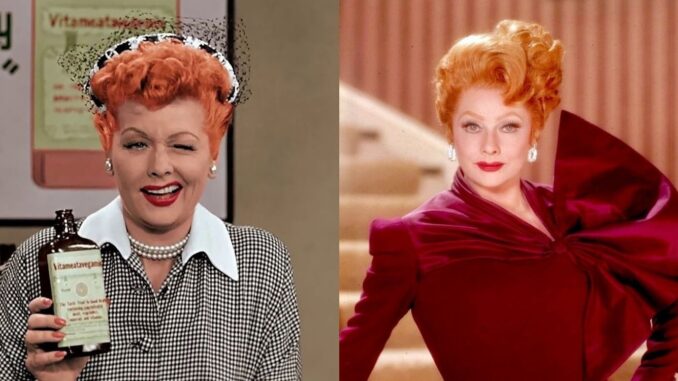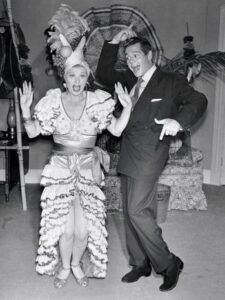
When we think of groundbreaking television, I Love Lucy stands tall as one of the first true giants in TV history. From its debut in 1951, I Love Lucy captured the hearts of millions, bringing laughter and a new level of relatability into American homes. But what made I Love Lucy such a ratings phenomenon? This article dives into the unique ingredients of the show’s massive success, from its innovative production techniques to the lovable, comically chaotic character of Lucy Ricardo.
The Start of a Legacy: How ‘I Love Lucy’ Began
A Revolutionary Debut in 1951
When I Love Lucy premiered in October 1951, no one could predict it would become an iconic cornerstone of American television. The show brought together the comedic genius of Lucille Ball and the on-screen chemistry with her real-life husband, Desi Arnaz, to create something entirely fresh.
The Power of Lucille Ball and Desi Arnaz
Lucille Ball’s physical comedy skills were unmatched, and her magnetic personality made viewers tune in week after week. Paired with Arnaz’s musical talent and Cuban charm, the duo brought a mix of humor and authenticity that became irresistible to viewers.
The Show’s Unique Production Choices
Filming in Front of a Live Audience

Most TV shows in the early 1950s were shot live or using multi-camera setups with laugh tracks. I Love Lucy broke new ground by filming in front of a live audience on film, preserving the energetic responses from viewers. This innovation contributed to a genuine and contagious humor that resonated with audiences everywhere.
Perfecting the Multi-Camera Technique
The use of a three-camera setup allowed the crew to capture different angles simultaneously, adding a cinematic feel to the sitcom that wasn’t typical at the time. This decision not only saved production costs but also made editing smoother, creating a polished, seamless look that set the show apart.
Why America Fell in Love with Lucy
Relatable Storylines and Characters
From Lucy’s often misguided but well-intentioned schemes to Ricky’s exasperated responses, the characters felt real, quirky, and instantly relatable. Lucy’s character brought laughter to ordinary situations, providing escapism and comfort to viewers navigating post-WWII America.
The Lovable Lucy Ricardo
Lucy Ricardo was charmingly flawed, a mix of ambition and naiveté, which made her lovable to audiences. Her laugh-out-loud antics allowed viewers to feel like they knew her, and her mishaps became topics of water-cooler conversation nationwide.
The Dynamic Friendships on Screen
Lucy and Ethel’s friendship was another major draw, embodying the ups and downs of real-life friendships. Their camaraderie was relatable, and their joint antics kept audiences chuckling, making them a memorable TV duo.
Timing Was Everything: A 1950s Audience Craving Humor
Post-War America Needed a Laugh
The 1950s were a time of cultural shift and optimism after the hardships of WWII. Families craved light-hearted entertainment, and I Love Lucy delivered, offering an escape that didn’t shy away from poking fun at everyday struggles.
Reinventing the Family Dynamic on Screen
The show presented a modern marriage between a native New Yorker and a Cuban musician—a bold move that embraced diversity. Ricky and Lucy’s marriage broke barriers, creating a more inclusive picture of the American family and inviting a broader audience.
The Role of Sponsors and Early Television Marketing
Partnering with Philip Morris
In an era where brand sponsorship drove programming, I Love Lucy landed a massive sponsorship deal with Philip Morris, securing its budget and allowing for higher production quality. This investment directly impacted the show’s ability to experiment and innovate.
How Ad Breaks Boosted Viewer Engagement
Sponsors knew that keeping audiences engaged during ad breaks was critical, and I Love Lucy made clever use of these interruptions. Rather than abrupt transitions, the show blended humor and gentle product placements to maintain viewer interest, ensuring higher engagement.
The Cultural Impact of ‘I Love Lucy’
Lucy as a Feminine Icon of Comedy
Lucille Ball’s character represented a shift in how women were portrayed on television. She wasn’t a passive character but a comedic force who could challenge societal norms, resonating especially with female viewers.
Introducing Ethnic Diversity to the American Audience
Desi Arnaz’s role as Ricky Ricardo showcased a Cuban-American lead on a major television network. This casting choice subtly celebrated diversity, broadening America’s perception of ethnicity in mainstream media.
Maintaining Viewership Across Generations
Reruns and Syndication: An Endless Legacy
I Love Lucy was among the first shows to benefit from syndication, keeping its episodes accessible to new generations. This syndication strategy allowed the show to maintain relevance well past its original airing.
A Show That Never Gets Old
The timeless humor of I Love Lucy and its relatable storylines ensure that it remains relevant, with reruns still capturing audiences today. From boomers to Gen Z, each generation finds something to love about Lucy.
The Numbers Don’t Lie: Record-Breaking Ratings
Consistently Topping the Charts
By its second season, I Love Lucy was the number one show in America, a position it would hold for four seasons. This ratings dominance was unprecedented and solidified the show’s place in television history.
Breaking the Record with “Lucy Goes to the Hospital”
The episode where Lucy gives birth to Little Ricky drew in over 44 million viewers, a record-breaking feat at the time. This broadcast eclipsed even Dwight D. Eisenhower’s presidential inauguration, proving that America couldn’t get enough of Lucy.
Why ‘I Love Lucy’ Still Matters Today
An Influence on Modern Sitcoms
Many of today’s sitcoms borrow elements from I Love Lucy, from the multi-camera setup to the live studio audience. Shows like Friends and The Big Bang Theory continue to emulate the successful framework pioneered by I Love Lucy.
A Benchmark for Female-Led Comedies
The show’s success paved the way for more female-led comedies, proving that audiences craved relatable female perspectives. Lucille Ball’s influence can be seen in contemporary comedic actresses who break traditional molds, from Tina Fey to Mindy Kaling.
Conclusion: The Lasting Legacy of a Cultural Classic
I Love Lucy didn’t just entertain; it changed the landscape of television, introducing innovative filming techniques, relatable characters, and groundbreaking social dynamics. The show’s universal appeal and timeless humor keep it alive in reruns, syndications, and the hearts of fans old and new. In the story of TV ratings, I Love Lucy remains a trailblazer and a benchmark for the success that modern shows aspire to achieve.
